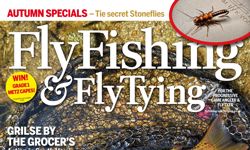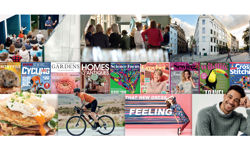Autism Eye, winner of a Media Pioneer Award at this year's Specialist Media Show, isn't just a powerful demonstration of how a small, independent, family-run publisher can secure worldwide readership through must-have editorial, canny exploitation of digital and a liberal dose of sheer determination. It's also proof that with the right product in the right market, launch success can be achieved - even in a recession.
Launched by husband and wife team Mark Hayes and Gillian Loughran in March 2011 after their young son developed regressive autism, Autism Eye is a quarterly specialist consumer magazine written by parents for parents and carers of children with autism.
Gap in the market
However, unlike other titles that have served this market, it is both independent and professionally-produced. The magazine's two co-founders are experienced journalists - Hayes, who formerly edited H-The Hotel Magazine and Hotel & Restaurant Magazine, is a former British Society of Magazine Editors editor of the year while Loughran is a past Professional Publishers Association editor of the year winner.
The motivation was simple, says Hayes: "We found there wasn't much useful information available when we really needed it, so we decided to provide it ourselves for other people just like us." While a wealth of information was accessible online, the issue was how to find information that was both reliable and independent, he explains: "Everyone out there has their own particular angle, so we decided ours should be to be well-researched, well-written, well-presented, properly useful and truly independent."
Unable to secure a bank loan to cover start-up costs, the pair backed the launch of their venture with around £10,000 from their personal savings - a gamble magnified by the fact that though both were journalists, neither had publishing experience. But their resolve was strengthened by the passion they had for the product they wanted to develop and the belief they had in the need it would serve.
The starting point was to talk to other parents to gauge levels of interest and for what type of magazine. Content would be focused around things parents would find useful: therapies, research, books, health and diet. Editorial tone, meanwhile, would be both practical and upbeat.
"We wanted to be inspirational and uplifting because it is our belief that there is a lot you can do as a parent of a child with autism to help your child and we wanted to express that sense of optimism through the look and style of the magazine," Hayes adds.
"There was so much to think about from scratch. What paper to use - we went with matt because parents wanted something informative and practical rather than glossy. What designer to use - luckily, I knew a good one already and it was the same with the printer. What web designer - this was difficult as I'd not had a website before, so I contacted GQ.com because they'd recently won a design award and someone from their in-house design team recommended a website design company called Module Media who've been great."
Loughran, the magazine's editor, took on responsibility for editorial content to be produced by herself and freelance contributors. Meanwhile Hayes was responsible for and did pretty much everything else. And inevitably, this meant spending money before the pair had any guarantee that in the not too distant future there would be money coming back in.
Problem of cash flow
"The greatest challenge was cash flow," he recalls. "This made prioritisation really important. When I started off in journalism, all you did was produce a magazine, either sold it on the newsstand or through controlled circulation and got the ads in. Now, though, there are so many things to get involved with - not just social media but digital media and search engine optimisation and brand extensions. Although we were really ambitious for the product, we had to take a lot of care not to try to do everything too fast so self discipline was essential."
A focus from Day 1 was on creating a high quality editorial product. As important, however, was ensuring their business plan balanced their need to cover costs and keep going with their desire to provide a valuable product to people like them at a reasonable price. "Often, parents with children who have autism are hard-pressed financially after paying for all the treatments and therapies their children need," Hayes explains. "Many of our advertisers, which include quite a few charities, have limited budgets, too. But while we initially viewed this as a kind of social enterprise, we weren't naive - it had to make money to keep going."
Autism Eye's business model is underpinned by a variety of revenue streams. A tiered cover price strategy ensures parents (who account for around 70 per cent of the readership) pay £20 for four issues - £10 less than organisations, with discounts offered to subscribers committing for more than a year. Price tiering also applies to overseas subscriptions and to the subsequently-launched digital edition. Advertising also has an important role to play - both in the magazine and online, and additional revenue is generated by a directory listings section on the Autism Eye website.
Autismeye.com was designed as a complementary platform rather than simply a digital version of the magazine posted online, Hayes stresses. It carries topical stories in between print publication as well as taster copy of each new edition to generate awareness and drive new subscriptions. Meanwhile its social media functionality makes it an important pillar in a simple social marketing strategy which has proven to be highly effective given the title's lack of formal marketing budget.
"We publish stories on the site and tweet them. We also use Facebook, LinkedIn and Yahoo groups to spread news and information further and generate debate," he adds. "And we have put together our own database of 1,000 or so journalists who we contact when we press release stories we have broken ourselves."
Stroke of luck
The net effect of all this helped quickly establish a strong profile for the brand amongst its target market. However another contributing factor, Hayes readily admits, was being in the right place at the right time.
"The first edition launched with just one ad - in part because we'd been so focused on getting the editorial right, although it was also hard to convince advertisers before there was a product to see," says Hayes. "Then, around the time we were putting together issue two, we were approached to be media partners for a new event taking place at London's ExCel in June 2011, The Autism Show. We took between two and three thousand copies to the event and almost all went on the first day."
After that, discussions with advertisers got easier: "Though I'd not sold ads before, I had worked with people who had and I found with the strength of our product, there was a lot of interest. There were a few who tried to do deals on editorial but we absolutely said 'no' and today, I'm pleased to say, we rarely get asked."
Eighteen months after launch, Autism Eye now sells 7,000 hard copies per issue to an international subscriber base and is turning a modest profit. The digital edition - a downloadable pdf accessible via a hyperlink developed in response to growing overseas demand for the title - is driving growth in international subscriptions and plans are now underway to staff up - a sales person will shortly be appointed to help manage advertising while the search has begun for a North American correspondent.
Where next?
Meanwhile, Hayes’s attention is now turning to possible brand extensions - a live event, maybe, he confides. And other titles? Certainly, in due course.
"What our experience proves is that if you have an idea of what you want to do - a clearly defined product for a specific market - you can become a publisher and publish successfully on a small budget. Also, it shows that you can take your life in your hands as an editorial person and launch something in a recession that not only survives but grows," he observes.
Being a small publisher has been a steep and rapid learning curve, Hayes readily admits, but also a highly satisfying one: "It's a lot to handle doing it all yourself, but I truly believe the future belongs to small publishers."
Smaller publishers are more adept at creating quality products on tighter budgets - one reason for the spate of titles shed by large businesses to smaller independents, in recent months, he points out, claiming that they are more nimble of foot and more passionate about constantly improving editorial.
Successfully launching a new publishing venture in the current climate depends on single-minded focus, a strong proposition serving a clearly defined market need, and diverse revenue streams to pay your way, he continues.
"Autism Eye isn't a magazine we envisaged we'd get rich with. But what we have done - not only have we successfully launched in a recession we're growing, too, while keeping a firm lid on costs - has given us the courage and some of the knowledge we will need to do something else," he adds. "It may well be that we launch another magazine in an entirely different sector - retail, grocery or hospitality, perhaps, where Gillian and I both have past experience.
We will diversify when we can afford to - it's certainly part of the plan."












